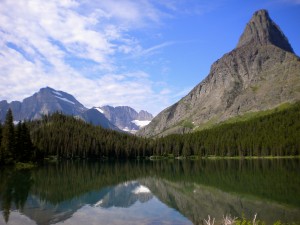Little Lake, OR
 Using XRF analysis and a time-series of cosmogenic 10Be erosion rates from an existing lake core, we quantify rates of chemical weathering during the Last Glacial and Late Holocene. Previously published results suggest erosion rates are 2-3X higher than present during the Last Glacial due to pervasive frost cracking (Marshall et al., 2015, 2017). Using XRF analysis of trace elements, we find that the chemical depletion fraction (Riebe et al., 2001) is a factor of two lower during the Last Glacial. Thus, chemical depletion and erosion rate appear to offset and the flux of weathered material remains constant in both climate intervals. This raises many questions about the efficacy of the hypothesized weathering-climate feedback on the glacial-interglacial timescale.
Using XRF analysis and a time-series of cosmogenic 10Be erosion rates from an existing lake core, we quantify rates of chemical weathering during the Last Glacial and Late Holocene. Previously published results suggest erosion rates are 2-3X higher than present during the Last Glacial due to pervasive frost cracking (Marshall et al., 2015, 2017). Using XRF analysis of trace elements, we find that the chemical depletion fraction (Riebe et al., 2001) is a factor of two lower during the Last Glacial. Thus, chemical depletion and erosion rate appear to offset and the flux of weathered material remains constant in both climate intervals. This raises many questions about the efficacy of the hypothesized weathering-climate feedback on the glacial-interglacial timescale.
Swiftcurrent Lake (Glacier National Park):
 Swiftcurrent Lake is the third lake in a chain of three (now four) meltwater lakes draining Grinnell Glacier, which sits in a small cirque at the head of Many Glacier Valley. We used a ~17,000 sediment core from Swiftcurrent Lake to accurately constrain glacial advances and geomorphic process throughout the Late Pleistocene-Holocene transition. We used a number of proxies including: %TOC, %TIC, C/N, grain size and XRD analysis of sediment in our work. Our data provide evidence for a distinct shift in climate from the Late Pleistocene to the early Holocene, as well as provide a case study in using carbonate minerals (from source rock) as tracers of glacial movement. Additionally, we presented well-constrained evidence for glacial advance during the Younger Dryas period, which our data show spanned from 12.75 to 11.5 ka in the Glacier National Park Area. Results are summarized in a Quaternary Research paper, published in 2015.
Swiftcurrent Lake is the third lake in a chain of three (now four) meltwater lakes draining Grinnell Glacier, which sits in a small cirque at the head of Many Glacier Valley. We used a ~17,000 sediment core from Swiftcurrent Lake to accurately constrain glacial advances and geomorphic process throughout the Late Pleistocene-Holocene transition. We used a number of proxies including: %TOC, %TIC, C/N, grain size and XRD analysis of sediment in our work. Our data provide evidence for a distinct shift in climate from the Late Pleistocene to the early Holocene, as well as provide a case study in using carbonate minerals (from source rock) as tracers of glacial movement. Additionally, we presented well-constrained evidence for glacial advance during the Younger Dryas period, which our data show spanned from 12.75 to 11.5 ka in the Glacier National Park Area. Results are summarized in a Quaternary Research paper, published in 2015.
